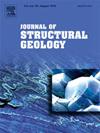Reading the marbles: Calcite decodes strain distribution during exhumation of high-pressure metamorphic rocks (Ios Island, Cyclades)
IF 2.9
2区 地球科学
Q2 GEOSCIENCES, MULTIDISCIPLINARY
引用次数: 0
Abstract
We present new calcite microstructural, petrofabric, and grain size data from high-pressure marbles to investigate spatio-temporal variations of deformation within the exhumed Cycladic Blueschist Unit (CBU) on Ios Island. Early exhumation of the CBU, from eclogite-to blueschist-facies conditions, was accompanied by the development of the mesoscopic foliation and isoclinal folds. Our results indicate static recrystallization during blueschist-facies conditions, evidenced by coarse columnar calcite grains oriented at high angles to the pre-existing foliation. Continued exhumation involved top-to-the-SSE shearing, localized at the base of the unit, as indicated by the dynamic recrystallization of columnar calcite via subgrain rotation. A subsequent reversal to top-to-the-NNW shearing caused intense deformation across the CBU from blueschist-to greenschist-facies conditions, producing a wide range of recrystallized grain sizes (∼500–∼20 μm). During the final stages of NNW-directed shearing, deformation localized at the top of the CBU within foliation-parallel bands, with differential stresses from 26 to >64 MPa, forming fine-grained (∼30 μm), nearly uniform recrystallized calcite through subgrain rotation and bulging recrystallization. These findings underscore the previously underestimated significance of foliation-parallel, NNW-directed shearing during ductile exhumation of the CBU on Ios Island and highlight the critical role of high-pressure calcite marbles in unraveling these tectonic processes.
解读大理岩:方解石解码高压变质岩挖掘过程中的应变分布(伊奥斯岛,基克拉迪斯)
我们利用高压大理岩的方解石微观结构、岩石组构和粒度数据,研究了在Ios岛出土的基克拉迪蓝片岩单元(CBU)中变形的时空变化。从榴辉岩到蓝片岩的早期发掘,伴随着介观片理和等斜褶皱的发育。我们的研究结果表明,在蓝片岩相条件下,静态再结晶,证明了粗柱状方解石颗粒与预先存在的片理成高角度。继续挖掘涉及到顶部到sse的剪切,局部位于单元的底部,如通过亚晶旋转的柱状方解石的动态再结晶所示。随后,从顶部到nnw的剪切作用发生逆转,导致整个CBU从蓝片岩到绿片岩的强烈变形,产生大范围的再结晶晶粒尺寸(~ 500 ~ ~ 20 μm)。在nnw向剪切的最后阶段,在26 ~ 64 MPa的应力差下,变形集中在CBU的顶部,通过亚晶旋转和胀形再结晶形成细晶(~ 30 μm)、几乎均匀的方解石。这些发现强调了之前被低估的薄片平行、nnw向剪切作用在Ios岛CBU韧性发掘中的重要性,并强调了高压方解石大理岩在揭示这些构造过程中的关键作用。
本文章由计算机程序翻译,如有差异,请以英文原文为准。
求助全文
约1分钟内获得全文
求助全文
来源期刊

Journal of Structural Geology
地学-地球科学综合
CiteScore
6.00
自引率
19.40%
发文量
192
审稿时长
15.7 weeks
期刊介绍:
The Journal of Structural Geology publishes process-oriented investigations about structural geology using appropriate combinations of analog and digital field data, seismic reflection data, satellite-derived data, geometric analysis, kinematic analysis, laboratory experiments, computer visualizations, and analogue or numerical modelling on all scales. Contributions are encouraged to draw perspectives from rheology, rock mechanics, geophysics,metamorphism, sedimentology, petroleum geology, economic geology, geodynamics, planetary geology, tectonics and neotectonics to provide a more powerful understanding of deformation processes and systems. Given the visual nature of the discipline, supplementary materials that portray the data and analysis in 3-D or quasi 3-D manners, including the use of videos, and/or graphical abstracts can significantly strengthen the impact of contributions.
 求助内容:
求助内容: 应助结果提醒方式:
应助结果提醒方式:


